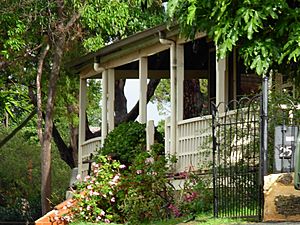The Cliffe facts for kids
The Cliffe is one of the very first homes built in the Perth suburb of Peppermint Grove. It is a special house because of its long history and the interesting families who have lived there. You can find it at 25 Bindaring Parade, Peppermint Grove.
Contents
What is The Cliffe?
The Cliffe was first designed by an architect named Clarence Wilkinson. It was built in 1894 for a businessman called Neil McNeil. Later, in 1899, more parts were added by another famous architect, J. Talbot Hobbs. Even more changes happened in the 1930s and 1960s.
The house is built in a style called Federation Bungalow. It is mostly made from a strong wood called jarrah. In 1914, a writer named Dr James Battye wrote about the house. He said that every part of the house, from the bottom to the roof, was made of jarrah wood. He also said that after nearly 20 years, the wood was still as good as new. The house had over 20 rooms and was surrounded by a large park with lawns and flowers.
The Cliffe's History
The Cliffe was built in 1894 or 1895 by Neil McNeil. He bought 10 acres (about 4 hectares) of land in 1892. This was just one year after Peppermint Grove was divided into building plots. Neil McNeil was one of the first five people to own land in this area. A street, McNeil Street, was even named after him.
Neil McNeil was part of a company called the Jarrahdale Timber Company. This company sold wood to pave streets in London a long time ago. Because he loved wood so much, McNeil built his home to show how amazing jarrah wood could be for building. However, the local council, the Peppermint Grove Road Board, later decided that houses should be built from brick and stone, not wood.
The house was changed and made bigger over the years. In 1896, a billiard room was added. After McNeil got married in 1900, more changes were made in 1906 by architect J. Talbot Hobbs.
In 1915, the large property was divided into 20 smaller pieces of land. But The Cliffe still kept a big garden area near the Swan River.
Who Lived Here?
After Neil McNeil passed away, the house was sold in 1927 to Lance Brisbane. He was an important businessman in Western Australia. When Lance Brisbane moved in 1933, his brother, David Brisbane, and his family lived at The Cliffe until David passed away in 1960.
Later, Dr Harold McComb, a plastic surgeon, and Dr Athel Hockey (AO), a famous geneticist, bought The Cliffe. They lived there until 1995. The McCombs had four sons. Two of them, David and Robert, were in a famous Australian band called The Triffids.
The Triffids and The Cliffe
The Cliffe was a very important place for The Triffids band. Between 1978 and 1981, they recorded many of their songs right there at The Cliffe. The house was a safe and inspiring place for them throughout their music career. It had a unique spot overlooking Freshwater Bay, which gave David McComb a special view and ideas. When he was a teenager and wanted to start a band, he and the other band members would practice in the cellar of The Cliffe. The large property meant they didn't disturb many neighbours.
Robert McComb, David's brother, said that the house really inspired his brother. He said, "The house was the home of the band while we were in Perth. The big rooms, lofts, and underground cellars we used to practice in were things most Perth houses didn't have. There was such a strong feeling there that Dave would come back to it for ideas."
The picture on the cover of The Triffids' last album, The Black Swan (1989), was taken in the stables behind the house.
Saving The Cliffe
In April 1995, the McCombs sold the house to a real estate agent, Christopher Shellabear. Harold McComb explained that their children had grown up and left home, so he and his wife felt the house was too big for them.
However, local people were worried that the house might be knocked down. So, on June 30, 1995, the Heritage Council of Western Australia stepped in. They issued an order to stop any work on the house. This was to protect its history.
Soon after, on July 17, 1995, Chris Shellabear sold the house to Sharon Creasy, whose husband was a prospector named Mark Creasy. The Heritage Council then added The Cliffe to the State Register of Heritage Places. This meant it was officially recognized as an important historical site. The Creasys disagreed with this for nine years. In 2004, the house was put on the permanent register. There was a legal disagreement about how this was done, so the Heritage Council officially re-registered it in May 2005.
The Cliffe Today
The Cliffe was saved from being knocked down. In 2013, a private family bought the property.


